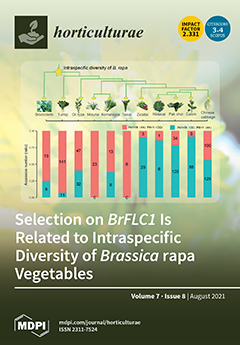The goal of this study was to examine how to improve the vegetative growth, nutritional status, productivity, and fruit quality of Washington navel orange trees by examining the effect of foliar application of ZnSO
4 (0, 300, and 600 mg/L) solutions in combination
[...] Read more.
The goal of this study was to examine how to improve the vegetative growth, nutritional status, productivity, and fruit quality of Washington navel orange trees by examining the effect of foliar application of ZnSO
4 (0, 300, and 600 mg/L) solutions in combination with CuSO
4 (0, 200, and 400 mg/L) solutions on Washington navel orange trees, which were 11 years old and grown in clay loam soil with a surface irrigation system. The results showed that all the investigated measurements responded specifically to each investigated factor. ZnSO
4 elicited a stronger and more effective response than CuSO
4. Nonetheless, the response varied only slightly or moderately from one measurement to the next. In terms of the interaction effect between ZnSO
4 and CuSO
4 concentrations, the effect of each investigated factor was directly reflected in its combinations, with ZnSO
4 (600 mg/L) and CuSO
4 (200 and 400 mg/L) being the most effective for the majority of the measurements under consideration. When the highest level of ZnSO
4 was combined with the highest level of CuSO
4, the highest values for the various vegetative growth parameters shoot length and diameter, number of leaves per shoot, leaf area, and total assimilation area per shoot were obtained. As a result, the nutritional status (the highest total leaf chlorophyll and leaf mineral contents) was significantly coupled with the treatment of 600 mg/L ZnSO
4 in combination with 400 mg/L CuSO
4. Moreover, the combinations of the highest ZnSO
4 concentration (600 mg/L) and CuSO
4 concentration (400 mg/L) exhibited the greatest statistical values of the measurements of fruiting aspects as well as fruit quality. Consequently, it can be recommended that using 600 mg/L ZnSO
4 in combination with 400 mg/L CuSO
4 as a foliar spray on monthly basis during the period from March to July could be safely recommended under similar environmental conditions and horticulture practices adopted in the present experiment.
Full article





